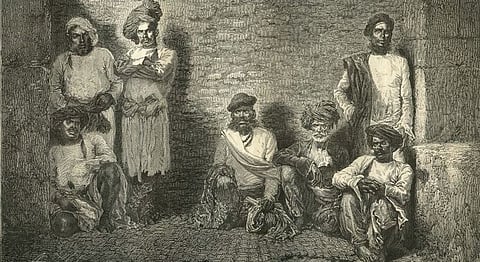
- HOMEGROWN WORLD
- #HGCREATORS
- #HGEXPLORE
- #HGVOICES
- #HGSHOP
- CAREERS
- ABOUT US
- CONTACT US

Fans of Indiana Jones and the Temple of Doom are probably among the few people that are acquainted with, or have heard of, the Thuggees. Although this Hollywood depiction of the group is more than a tad bit inaccurate, it does shed light on this little known group.
The first known reference to Thuggees as a brotherhood, of sorts, was in History of Firoz Shah, written by Ziauddin Barni in 1356. These people hold the position of being the world’s first organized mafia in recorded history, and it is definitely no coincidence that the English word ‘thug’ is derived from the Thuggees and their activities.
An organized gang of professional murderers and robbers, they’d travel in groups across the Indian subcontinent, and according to Sir William Turner, they “made it their business to frequent the great highways of India and become friendly with travellers, with a view to setting upon them and strangling them.”
The gang worked in an extremely systematic manner, picture a typical infiltration scheme in any of your spy movies. The core idea was to join a group of travellers, stay with them long enough to ward off any wariness or doubts they might have.
Then, having studied the geography of the land thoroughly, they would either attack the travellers at night or during a rest break; this ensured complete unpreparedness and the background noises could effectively subdue the cries of the victims. The victims were strangled by 2-3 men and either buried or thrown into a well.
The Thuggees even favoured specific spots, known as beles, to carry out the killings. In case of larger groups, the Thuggees would join them on their route in small groups at irregular intervals, and show no signs of recognition of the other gang members present. This happened until the number of Thuggees outnumbered the travellers, and then it was the strangle-bury-loot routine.
Membership was largely hereditary, passed from father to son. Sometimes, the Thuggees would take in the children of the travellers and train them in the ways of the thug life, which made them less conspicuous.
What really interested us about the Thuggees was the multiple religious backgrounds of the members - there were Hindus, Muslims and a few Sikhs. The Thuggees worshipped Kali, and it is believed that the Muslim members were of an Islamic cult of assassins from Iran, who believed that the goddess Kali was a manifestation of Fatima.
This theory is unproven, but there is solid evidence in the form of the arrest records of the British that Muslims were members of the Thuggees too. Historian Mike Dash theorises that the Thuggees had no religious motivations, but merely resorted to thievery out of sheer poverty, which could also explain their multi-religious aspect.
Holding a Guinness Record of over 2 million kills in their time, the Thuggee menace came to an end as a result of a crackdown by the British. In the 1830s, Feringhea (known as Syeed Amir Ali) was captured by the civil servant William Henry Sleeman.
He took Sleeman to one of the beles, and named the Thuggees involved in the murders of the people whose bodies were hidden there. The Thuggee and Dacoity Department was established in 1835 by Sleeman, and the campaign was a success. Thousands were arrested, many became informants; the men were imprisoned and the women, along with children, were housed in convents.
In late 19th century, a new theory, suggested by Martine van Woerkens in her book The Strangled Traveler: Colonial Imaginings and the Thugs of India, emerged that the Thuggees were a creation of the East India Company. She puts forth that there was no such group, it was a conceived notion by the British who feared the increasing power of rural dacoits, and their unfamiliarity with the rural lifestyle posed a threat to their position of power, and hence, they issued an ‘anti-Thuggee campaign’ to position their rules, laws and people into these areas.
Now, we can neither prove nor disprove whether they were a ‘colonial imaging,’ but the legacy (be it good or bad) left by the Thuggees and their activities cannot be denied. With no complete records of exactly how many people were killed at the hands of this murderous cult of bandits, if the popular lore about the Thuggees holds true, then they could just be the most dangerous group of people in history.
If you enjoyed this article we suggest you read:
